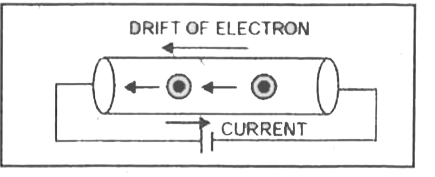(a) Derive a relation between electric current and drift velocity of charge carriers.
9b) Deduce the expression for resistivty.
(c) What is the effect of temperature on resistivity?
Ohm.s law. It states that current flowing through a conductor is proportional to the potential difference across its two ends, provided to physical conditions (temperature, mechanical strain etc.) of the conductor remain unchanged.

Drift velocity (vd) is the velocity of the free electrons with which they are drifted towards the positive terminal under the influence of the external field.
(a) Relation between electron current and drift velocity. consider that a wire of length l and area of cross-section A be subjected to an electric field of strength E.
If V=Potential difference applied across the end of the wire,
∴E=VlorV=El
Let n=number of free electrons per unit volume of the conductor, vd= Drift velocity of electrons
∴ Charge flowing through the conductor wire=nA
le
Time taken by the electrons,
t=DistanceVelocity=lvd
∴Current, I=ChargeTime=nAlelvd
I=nvdAe . . . (i)
Since current density J=IA
So J=nvde
this is the required relation between current and drift velocity.
(b) Expression for Resistivity. According to Ohm.s law,
V=IR
or V=(vdnAe)R
E=Vl=vdneAlR
Force acting on each electron
eE=ne2ARlvd
Acceleration under electric field=(a=eEm)
eEm=(ne2m)ARlvd . . (ii)
∴ Velocity acquired by the electron under the action of applied electric field is
∴Velocity acquired by the electron under the action of applied electric field is
vd=eEmτ
Where τ=relaxation time in which the electron is accelerated substituting vd from above in equation (2), we have
eEm=(ne2m)ARl×eEmτ
∴ARl=mne21τ [∵ρ=ARl]
ρ=mne21τ
This is the required expression for resistivity.
(c) Variation of Resistivity with temperature
Resistivity ρ=mne21τ
∴ρ∝1τ
The resistivity varies with relaxation time. the relaxation time changes with collision. it will decrease with increase amplitude of vibration. since with the increase in temperature, the amplitude of vibration increases, relaxation time decreases and hence resistivity increases.
In many metals, at room temperature resistivity increases with increase in temperature. at low temperature, resistivity increases at a higher power of T. this is shown in the figure.
Related Playlists
- BOOK - MBD -HARYANA BOARDCHAPTER - CURRENT ELECTRICITYEXERCISE - OBJECTIVE TYPE QUESTIONS20videos
CURRENT ELECTRICITY
- BOOK - MBD -HARYANA BOARDCHAPTER - CURRENT ELECTRICITYEXERCISE - SHORT ANSWER TYPE QUESTIONS9videos
CURRENT ELECTRICITY
- BOOK - MBD -HARYANA BOARDCHAPTER - BOARD QUESTION PAPER (SOLVED) - 2019EXERCISE - LONG ANSWER TYPE QUESTIONS4videos
BOARD QUESTION PAPER (SOLVED) - 2019
- BOOK - MBD -HARYANA BOARDCHAPTER - DUAL NATURE OF MATTER AND RADIATIONSEXERCISE - OBJECTIVE TYPE QUESTIONS17videos
DUAL NATURE OF MATTER AND RADIATIONS
Similar Questions
Give relation between drift velocity and electric field.
View SolutionDerive the relation between current and voltage in a purely resistive circuit ?
View SolutionWrite a relation between current and drift velocity of electrons in a conductor. Use this relation to explain how the resistance of a conductor changes with the rise in temperature.
View SolutionWrite a relation between current and drift velocity of electrons in a conductor. Use this relaxation to explain how the resistance of a conductor change with the rise in temperature.
View SolutionRelation Between Drift Velocity And Current
View SolutionRelation Between Drift Velocity And Current
View SolutionDrift Speed|Relation Between Current & Drift Velocity|Questions
View SolutionRevision |Relation Between Electric Current And Drift Velocity |Ohm's Law|Mobility |Battery
View SolutionWrite the mathematical relation between mobility and drift velocity of charge carriers in a coductor. Name the mobile charge carriers responsible for conduction of electric current in (a) an electrolyte (b) an ionised gas.
View SolutionWrite the mathematical relation between mobility and drift velocity of charge carriers in a coductor. Name the mobile charge carriers responsible for conduction of electric current in (a) an electrolyte (b) an ionised gas.
View Solution

